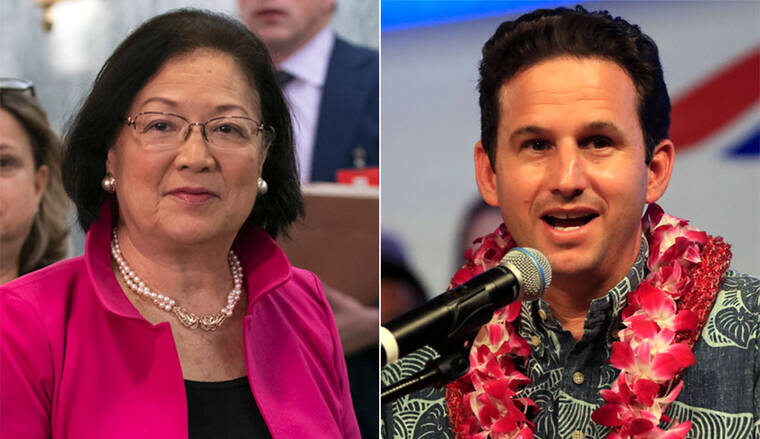Hawaii U.S. senators offer bill to aid evacuation route planning

STAR-ADVERTISER FILE
Sen. Mazie Hirono, left, Sen. Brian Schatz.
With August’s wildfire disaster in Lahaina in mind, Hawaii’s U.S. senators joined a pair of Senate colleagues Wednesday to introduce legislation that seeks to develop transportation guidelines for state and local governments to improve emergency evacuations.
The Emergency Vehicle and Community Planning Act directs the U.S. Department of Transportation, in consultation with the Federal Emergency Management Agency, to develop general guidance and best practices for states, territories, tribes and local governments for use in transportation infrastructure planning.
The bill was introduced by Hawaii Democratic Sens. Brian Schatz and Mazie Hirono, along with Sen. Alex Padilla, D-Calif., and Sen. Bill Cassidy, R-La.
“In an emergency, evacuation routes are absolutely critical to getting people to safety,” Schatz said in announcing the legislation. “Our bill will give communities the support they need to develop roadways that will help save lives.”
Wildfires across the country have become increasingly intense and destructive in recent years, including in Hawaii. According to the Environmental Protection Agency, the area burned by wildfires each year appears to have increased since the 1980s.
The Lahaina fire and California’s Camp Fire in 2018 were among the most devastating to communities in recent years. In both cases, limited evacuation routes were choked with traffic, preventing victims from escaping the flames.
Don't miss out on what's happening!
Stay in touch with breaking news, as it happens, conveniently in your email inbox. It's FREE!
Among the things that shockingly stood out in the inferno that overwhelmed Lahaina were the gridlocked roads and the burned cars that apparently were trying to escape.
“As natural disasters and extreme weather events — such as wildfires — become increasingly common in the U.S., it is crucial that our communities have effective, reliable emergency evacuation routes,” Hirono said in a statement.
Hirono said the new proposal would help Hawaii and other states strengthen emergency preparedness and develop infrastructure that prioritizes the safety of communities.
State Department of Transportation Director Ed Sniffen said he would welcome the help.
“Hawaii Department of Transportation works with our state and county emergency management agencies, first responders and local communities on alternative routes where feasible, and we appreciate the effort by Sens. Schatz and Hirono, together with their colleagues in the U.S. Senate, to introduce legislation to support state and local governments in emergency evacuation planning,” Sniffen said in a statement.
An organization called Streetlight Data surveyed 45 states on the mainland and found 675 communities with limited evacuation routes. Many of them were in coastal regions but others were found in canyons and on lakes.
Hawaii has a significant evacuation route problem, said Elizabeth Pickett, co-executive director of the Hawaii Wildfire Management Organization.
The organization’s most recent statewide survey, she said, found more than half of island communities with only one way in and out, a dangerous situation given the ongoing rise of wildfires in Hawaii, driven by the changing climate and spread of flammable grasses and brush.
Pickett said most island communities were developed without wildfire in mind. But now planning departments, with Kauai leading the way, are having to increasingly address evacuation route planning, she said.
As for existing communities with evacuation route deficits, some are looking for different solutions, such as identifying safety zones. One community, for example, is looking at using a golf course for vehicle refuge, she said, while another is considering staging canoes for an ocean escape.
Pickett said she welcomes any legislation that shines a spotlight on the issue.
“Now it’s about catching up,” she said.
Nationally, the bill has been endorsed by the National Association of Development Organizations and National Association of Counties.
“When disasters strike, county officials and emergency responders play a critical role in immediate and long-term efforts to help our communities respond and recover,” National Association of Counties Executive Director Matthew Chase said in a news release. “The bipartisan Emergency Vehicle and Community Planning Act would provide us with additional insights into developing and implementing evacuation routes to keep our residents safe before, during and after a disaster.”



